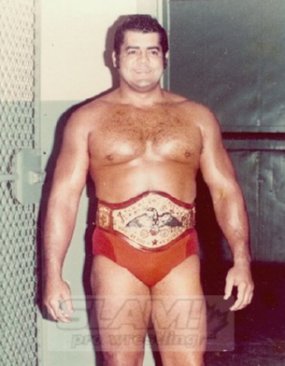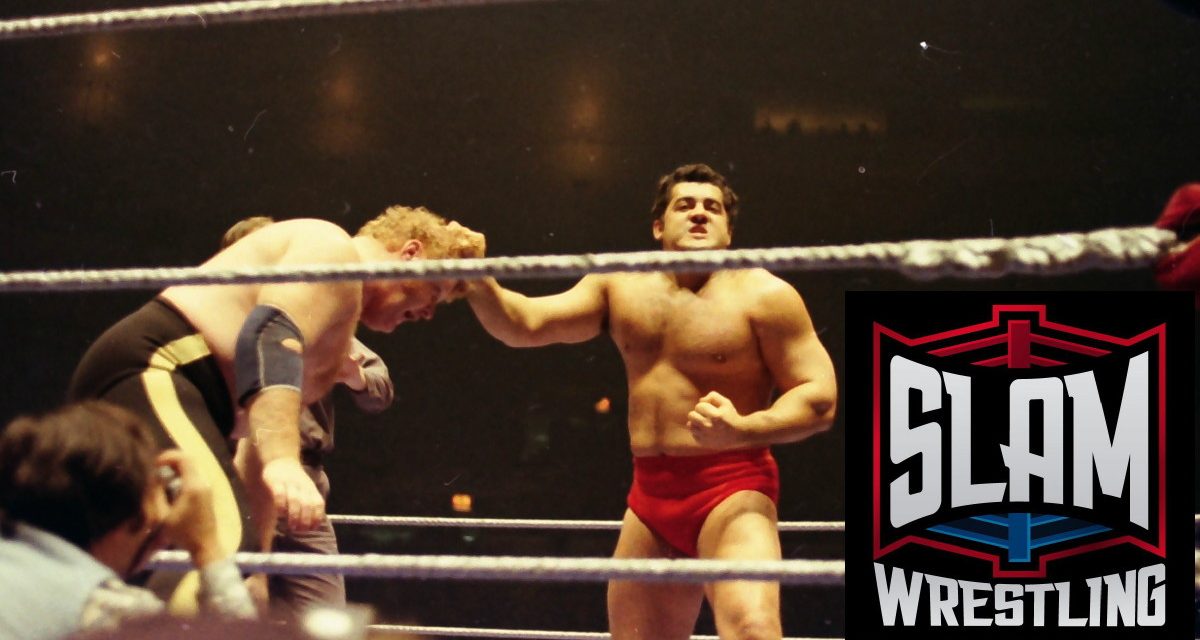
Pedro Morales. Courtesy Chris Swisher
Pedro Morales, the energetic Puerto Rican star who rose to become WWWF World champion from 1971 to 1973, has died. He was 76. The news was first reported by Hugo Savinovich on his Facebook page, and confirmed by WWE.
He was one of the biggest drawing cards in the wrestling business in the 1960s and 1970s.
“He was a great talent,” raved The Destroyer (Dick Beyer). “Everything you wanted him to do, he could do. We never had a bad match, that’s what I liked about working with Pedro. You could go in the ring, you could go 20 minutes, 30 minutes, an hour, and you could do it with Pedro.”
It would be wrong to say that Morales only appealed to the Hispanic market. Writer Jackson Pokress tried to capture Morales’ magic in a piece titled “Morales – Hero – Champion – Idol …”
“The fans turned out first out of curiosity, and then returned because Morales is not only exciting to watch, but he is a highly skilled wrestler who makes up in ability and speed what he may lack in strength and power.
“The cities with their large Puerto Rican and Spanish populations have, of course, taken Morales to their hearts. He is the idol they have been looking for in a sport where they are among the greatest rooters. But even in towns and cities where Pedro doesn’t enjoy a large and vocal following he has become a fan favorite.”
The 5-foot-11, 240-pound Morales was born on the tiny island of Culebra, October 22, 1942. The island housed an American navy base and was governed by Puerto Rico. He was an accomplished baseball player growing up, but a move to Brooklyn, NY, as a teen changed a potential career path.
His first professional match came in 1958 at the Sunnyside Gardens in Queens, and his father had to sign some paperwork to allow him to fight.
Though he was in some solid mid-card programs, often teaming with Miguel Perez or Argentina Apollo, it became apparent that he wasn’t going to go very far in the northeast, and headed out to get seasoning. In Amarillo and the Pacific Northwest, he was Johnny Como for a decent stretch, but in Hawaii, he worked under his real name.
“I think that was one of the best places, because I loved the beach,” Morales said of Hawaii, where they wrestled only three or four times a week. “I was born and raised on the ocean, on the island of Culebra. Culebra is only 28 square miles. My grandfather had a big sailboat, and could fit 25 head of cattle inside. I grew up in Culebra in a place right on the ocean. … Before I came to the United States, I was in the ocean all the time. I loved the ocean.”
In California, though, he became a star.
The WWA World title found its way to his waist in March 1965. The Long Beach Independent Press-Telegram talked to him just before he knocked off The Destroyer for the belt.
“Outside Morales’ dressing room at the Long Beach Auditorium, the cheers still resounded. For Pedro is the people’s choice. Little tykes beg for his autograph and little old ladies jab pins into his opponents. And even his most dastardly opponents have learned to respect the 22-year-old Latin hero,” reads the story.
For the next number of years in California, Morales reigned as a singles star, and in tag teams with Luis Hernandez, Mark Lewin, Ricky Romero and Victor Rivera.
“Pedro was a big crowd pleaser. He had that energy and that spark,” said Jeff Walton, the publicist for the Los Angeles office. “He was one of the first Latino stars that really sparked the area and the crowds here. There were others before him, that were here, but a lot of them were local guys, and he really came in and made quite an impression.” The promotion was careful not to promote him as a Puerto Rican, however. “If you mentioned Puerto Rican to the Mexican population, they kind of tune them out actually.”
In Hawaii, ethnic makeup wasn’t an issue, said promoter Ed Francis. “There’s so many different kinds of people there, Filipino, Japanese, Chinese, so many different kinds of people, Portuguese, people didn’t pay any attention to that kind of stuff.”
Promoter Vincent J. McMahon knew his fanbase was heavily ethnic, and had had his eye on Morales for years. With his World champion, Bruno Sammartino, demanding time off, McMahon needed a new draw. Morales returned to Madison Square Garden on January 18, 1971, the night Sammartino was dethroned by Ivan Koloff. Three weeks later, Morales knocked off Koloff for a title run that went until December 3, 1973, when Stan Stasiak surprised Morales, and subsequently lost the title back to Sammartino.
Photographer George Napolitano was at ringside when Morales beat Koloff. “Despite what people say, what I really remember is that there was a hush, it was a quiet. Nobody really expected it to happen. It was more surprise than jubilation,” he recalled. “They were happy, yeah, but they just didn’t expect it. It wasn’t like, ‘Wow, look at this!’ It was more subdued silence and respect, like, ‘Wow, he really did it.'”
“Like Bruno Sammartino, Pedro Morales was an ethnic hero. When he wrestled in Madison Square Garden, the Bronx emptied out, and every Puerto Rican in the borough filled the arena,” wrote Freddie Blassie in his autobiography. “If you were roughing him up, all he had to do was give the high sign, and he’d have twenty-thousand tag team partners charging the ring.”
Parade, a national newspaper insert, described the champ in April 1972: “Morales, whose soft-spoken, courteous manner contrasts with his bulging chest and shoulder muscles, is reflective of the growing interest in wrestling in cities with big Puerto Rican populations. Portraits and posters of Morales are sold in Madison Square Garden almost like saintly relics, and his fans come armed with Puerto Rican flags which they wave furiously when he pins an opponent.”
Not a big man, and surrounded by giants, the left-handed Morales relied on his fire and intensity to sell his skills to the masses. Slapping his chest to get himself motivated and rev up the crowd, his emotive face could convey emotion to the back rows.
Author Kevin Sullivan penned a book about the WWE Championship, and posted some of his unused transcripts on his Word Press site, including a conversation with Howard Finkel, the de facto WWE historian:
Why was he so great? Because the key was that the people believed in him. That is one of the things that is so pertinent. That’s a lost art in today’s sports-entertainment, but he was able to make people believe him. Ethnicity also played a big part. Pedro, as a Puerto Rican in the Northeast, was god. I was a fan back then and I would attend a lot of shows and there were always a lot of Puerto Ricans in attendance. I’m not saying that’s the whole reason, but Pedro had the believability. He also had another lost art — the interview. He used to talk about the live events coming to your town … we don’t do that any more. Pedro would come and say “you know what, Vince McMahon, I have a lot of support in Springfield (or whatever the next town was) and I need you fans to come out and support me.” And then all of a sudden, here’s the ethnicity—he did a 180 and spoke in Spanish for a few minutes. If that didn’t sell tickets to that segment of the audience then nothing will. So that was one of the keys. People like he and Bruno had that support.
After he dropped the title to Stasiak, he took it easy, settling into life in Woodbridge, NJ, where his wife, Karen, taught elementary school, and where their son, Pedro Jr., grew to 6-foot-10 and landed a basketball scholarship at University of North Carolina-Charlotte.
But the need to compete remained, and in 1980, Morales added to his legacy, claiming the WWWF tag titles with then-World champ Bob Backlund — they had to relinquish, since the World champ was prohibited from holding both titles — and then the Intercontinental title on two occasions. To this day, Morales has held the IC belt longer than any one else, taking into account both title runs.
“I enjoyed working with Pedro,” said Ken Patera, who dropped the IC title to him. “He had a good fan base other than the Puerto Ricans. Of course, when I worked with him, every Puerto Rican within 200 miles would show up, especially up there in Massachusetts, Worchester, Boston, Portland, Maine, New Haven, Connecticut. He had a good following.”
“Irish” Davey O’Hannon traveled and wrestled with Morales around the Northeast, and witnessed both the ego — “Pedro would walk into a place and think that everything should stop and focus on him” — and the reason for it, like a 24-hour sandwich shop, deep in the Bronx. “We pulled into a little Bodega and went in to get a sandwich, and the place went nuts. It was Pedro. And this was 11 o’clock at night, it was a 24-hour place. Oh man, he hit that door, he could have walked away with the store if he wanted to. It was unreal. He was wildly popular here.”
Later, Morales would challenge IC champion Randy Savage for the title as the WWF expanded nationally, with a viciously draining schedule. He quit in 1986, with a last bout in a legends battle royal in 1987, and became a Spanish commentator for the WWF and then WCW.
With WCW, his announcing partner was Miguel Alonso. “Pedro is a legend,” Alonso said in a 1997 edition of WCW Magazine. “What amazes me about Pedro is, he is retired, yet young kids, wherever he goes, yell out his name: Pedro, Pedro, Pedro. It is amazing how the people love him, especially the young ones.”
Having saved and invested his money well, the retired Morales was content to manage his businesses, some of which were back on Culebra, work out at the gym, and grow tomatoes in his garden. It was rare to get him out of the house, especially for wrestling events. Savio Vega accepted Morales’ induction into the WWE Hall of Fame in 1995.
Over the last number of years, Morales’ health faded, his body broken down, shrunken down to 180 pounds, using a cane to get around.
O’Hannon accepted Morales’ induction to the Professional Wrestling Hall of Fame in May 2015, and later delivered a plaque to his friend.
“He did the business the right way. He got in that ring and never left anything in there,” O’Hannon said during Morales’ induction. He treated the little towns the same as the big arenas. “People got the same thing from Pedro, their money’s worth.”
Morales died on February 12, 2019. Funeral information is not known at this time.
— with files from Steven Johnson
PEDRO MORALES STORIES
- Jan. 2, 2021: A loving, championship chat with Pedro Morales’ widow
- Apr. 8, 2016: Morales vs Mulligan: The knifing in Boston
- June 20, 2005: Morales emerges as highlight of reunion

